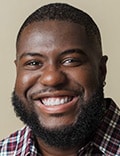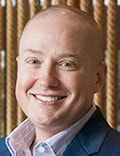Gregory Hunt moved around a lot as a child. Born in Sicily, Italy, he moved back to the US with his military family when he was 11 years, eventually landing in Orlando, Florida.
He grew up with few resources and education was not a priority in his family, he said. “Learning has always been a challenging thing for me,” he said.
He knew he wanted to be a doctor in high school, but an academic advisor discouraged him after he failed a couple of classes in his first semester of college. Disappointed, he followed his advisor’s suggestion and changed his major to psychology with a minor in health sciences.
Hunt ultimately did well enough in college achieving over a 3.0 grade point average (GPA) and excelling in “many areas,” but “it was very discouraging, when you hear your academic advisors saying like, ‘Oh, I don’t think med school is for you, I think you need to look into different alternatives,’” Hunt told Medscape Medical News.

But a few years after college, his dream of being a doctor caught up with him. While he worked at a nursing home, nurses noticed his people skills and his curiosity about medications. They asked him if he’d ever considered becoming a doctor.
“That really like pushed me,” said Hunt, who then applied to US medical schools but didn’t get accepted anywhere. One school accepted him into a gateway master’s degree program but there was no guarantee that once he completed the program he would get into the medical school, and he didn’t want to take that chance. When he saw a YouTube ad for Saint James School of Medicine with campuses in Anguilla and St. Vincent and the Grenadines, he applied. He was accepted, and he moved in less than a month.
“What led me to Saint James, to the Caribbean, was I just wanted a chance,” he said.
“Caribbean medical schools serve a very interesting purpose,” said Ryan Gray, MD, founder and CEO of MedicalSchoolHQ.net, “and a lot of that is to train students who, for one reason or another, can’t get into a US medical school or don’t want to put in the time to remedy something in their application that’s causing them not to be able to get into a US medical school. The biggest of those are going to be GPA and MCAT [medical college admission test] score.”

While US medical schools typically start in the summer every year, international schools — many based in the Caribbean — will usually have three or four different start dates “to try to get as many people through the system as possible,” Gray said.
“It’s a very quick application process to a Caribbean school and potentially start in a couple of weeks,” he said. “It’s a very easy lure for students.”
“Unfortunately, a lot of students think that Caribbean medical schools are a shortcut to a medical degree, but that couldn’t be further from the truth,” Gray said. “It’s hard. It’s medical school.”
Is a Caribbean medical school the right choice for an aspiring doctor and, if so, what are the key factors to consider?
When to Consider a Caribbean Medical School
Pre-med students should only consider an international or Caribbean medical school if they have applied and not gotten accepted to a US allopathic (MD) or osteopathic (DO) medical school, Gray advises students. Apply to US medical schools three times, he said, before even considering applying abroad.
If you apply to a US medical school and don’t get in, try to figure out the weaknesses in your application, Gray said. For example, if you need a higher GPA, take more classes. If the issue is your MCAT score, figure out how to improve it by getting a tutor or signing up for a program. Unfortunately, all of that does cost money, Gray acknowledged.
Caribbean medical schools often get a bad rap, Gray said, because they are for-profit, as are a minority of medical schools in the US. Being for-profit doesn’t make them good or bad, “but the practice of accepting as many students as possible and kind of dealing with potentially high attrition rates is an unfortunate practice at some of these Caribbean medical schools,” he said.
If improving your applications to domestic medical schools doesn’t work, then know that the best candidate for a Caribbean medical school is someone who has proven themselves academically, but for some reason the MCAT “doesn’t click for them” even after multiple tries, Gray said. That student is probably going to do fine in medical school because the MCAT is not like other tests they’ll face in the remainder of their training, he said.
“At the end of the day, an individual student’s success comes down to the amount of work that they’re willing to put into it, whether you’re at a US institution or an international institution,” he said.
He’s seen students reach out who got kicked out of a Caribbean medical school and now want to try again to get into a US school. “And it’s a long, long potential issue to get into that because they’ve already proven once they can’t handle medical school,” Gray said.
Student Experience Varies
Students who leave the US for medical school report have mixed feelings about their academic experience and their futures in medicine, according to preliminary data from a Medscape report that will be published later this year.
On a scale of 1-5, with 5 being the best, 50% of students who go to a medical school outside the US (OUS) rated their school’s clinical rotations as 4 or a 5 compared with 63% of US students.
And while 81% of US students said they were either very satisfied or somewhat satisfied with their overall clinical instruction, only 57% of OUS students said the same. On the same question, 30% of OUS students said they were very or somewhat dissatisfied compared with just 8% of US students.
Despite those numbers, more OUS students said they were very confident or somewhat confident that they will develop the practical skills in medical school that are needed in residency — 47%-44% for US students.
Too Long a Wait
Not everybody follows the suggestion to apply to medical school three times.
Growing up, Victor Adedara, now a 4th year medical student at St. George’s University School of Medicine (SGU) in Grenada, saw many doctors in the New York and New Jersey area who were graduates of the school. He had applied to US osteopathic (DO) medical schools and was waitlisted at one, but the wait was too long, he said. SGU also offered him a full scholarship.
SGU — considered one of the “Top Four” Caribbean medical schools — boasts a 95% US residency placement for US graduates over the last 5 years. The school is approved by key regulatory bodies including New York, New Jersey, and California state boards as well as the Florida Commission for Independent Education, according to SGU.
However, many students at international medical schools are “…at a disadvantage at almost every turn,” Gray cautioned.
About 93.5% of US MD seniors matched to first-year residency positions in 2025, within the historical 92%-95%, according to the National Resident Matching Program, whereas only 67.8% of US international medical graduates matched to postgraduate year-1 positions.

If you are thinking about applying to a Caribbean medical school, consider asking that school about residency match rates and US Medical Licensing Examination pass rates.
Also ask about clerkships and away-elective opportunities at hospitals with attached US residency programs. “So it’s their opportunity to kind of audition, so to speak, for residency and show how good they are, because they’re going to need letters of recommendation from these physicians who they’re rotating with,” Gray said.
“I think ultimately the thing to understand is that any school outside of the US is not an accredited US institution,” Gray said. The exception is Puerto Rico, where medical schools are accredited by the Liaison Committee on Medical Education (LCME) which certifies all US allopathic (MD) medical schools. Students at international medical schools will have to apply for certification from the Educational Commission for Foreign Medical Graduates before coming back to the US for residency training.
‘Forced to Overcome’
Attending a Caribbean medical school could be a culture shock, Gray said.
Being in the Caribbean is a struggle, Hunt said. “You see people on the street. You see lack of access to healthcare. You see a whole bunch of poverty.”
And sometimes there is no electricity, power, or water. Hunt learned he needed actual textbooks due to the fluctuating power supply, making his electronic devices unreliable. There also isn’t top-notch equipment or the newest edition textbooks. “It’s a very rough adjustment,” he said.
It can also be hard to make a phone call or get home to visit family, Hunt said. He visits family back in Florida every 6 or 7 months.
It’s also self-directed much of the time, he said. “You’re going to be alone in a room and you’re going to be talking to yourself.” He decided to slow down his academic pace to 2.5 years of basic sciences and will complete that in May 2026 before moving on to clinical rotations.
But there is beauty in the toughness. “You’re in intense environments every single day, so you’re forced to overcome,” Hunt said.
He’s also had opportunities to participate in research, to take part in a service-learning trip in Peru, and to network with a large group of classmates, many of whom share his values. “I think the common trait that international students have is that ‘no is not an option,’” he said.
The third and fourth year of medical school is totally self-directed at SGU, Adedara said, which he likes. He did some clinical rotations in the UK. Going to another country and trying to learn the system is a very interesting thing, he said. “Not everyone can go to a different country and adapt, so it made my adaptability skills become better.”
“It’s been a great time because going to Grenada, going to the UK, going to Europe, I understand, I could live in different places, and I still survive. I can understand (the) way things are being done in different countries,” he said.
Adedara and Hunt’s opportunities come with a significant price. While Adedara received a full scholarship to cover tuition at SGU, he still expects to owe approximately $120,000 when he graduates. Hunt will have to pay a lot more. Some Caribbean medical schools such as SGU can offer loans from the US Department of Education but others do not. Hunt had to take out private loans at a 15% interest rate. He anticipates owing $250,000 for medical school. He’ll also need to pay back loans he took out for his MBA degree he is pursuing. According to the Education Data Initiative, medical school graduates, as of last August, carry an average educational debt of $234,597, not including undergraduate debt. “Private loans are an unfortunate part of many of the international medical schools,” Gray said in an email. “There are a few [international medical schools like SGU, Ross University School of Medicine, American University of the Caribbean School of Medicine (AUC) and Saba University School of Medicine]…that do have the ability to get federal loans. Private loans are usually not flexible with needing forbearance or have any of the income-based repayment options.”
Hunt is willing to take on the expense, hoping the additional business degree he’s pursuing and a book that he’s working on will ultimately help him pay them back.
“I just wanted the school to see me for who I was and understand that I am a motivated and self-driven individual,” Hunt said, “And that’s what I got from being in the Caribbean.”
“They accepted me for who I was. They accepted me for my potential.”
Gray reported no conflicts of interest.


 Admin_Adham
Admin_Adham


